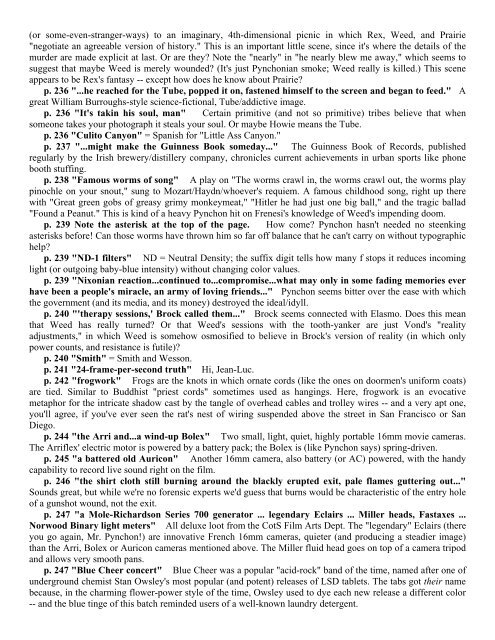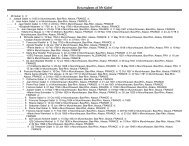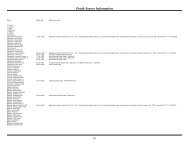You also want an ePaper? Increase the reach of your titles
YUMPU automatically turns print PDFs into web optimized ePapers that Google loves.
(or some-even-stranger-ways) <strong>to</strong> an imaginary, 4th-dimensional picnic in which Rex, Weed, and Prairie<br />
"negotiate an agreeable version of his<strong>to</strong>ry." This is an important little scene, since it's where the details of the<br />
murder are made explicit at last. Or are they? Note the "nearly" in "he nearly blew me away," which seems <strong>to</strong><br />
suggest that maybe Weed is merely wounded? (It's just Pynchonian smoke; Weed really is killed.) This scene<br />
appears <strong>to</strong> be Rex's fantasy -- except how does he know about Prairie?<br />
p. 236 "...he reached for the Tube, popped it on, fastened himself <strong>to</strong> the screen and began <strong>to</strong> feed." A<br />
great William Burroughs-style science-fictional, Tube/addictive image.<br />
p. 236 "It's takin his soul, man" Certain primitive (and not so primitive) tribes believe that when<br />
someone takes your pho<strong>to</strong>graph it steals your soul. Or maybe Howie means the Tube.<br />
p. 236 "Culi<strong>to</strong> Canyon" = Spanish for "Little Ass Canyon."<br />
p. 237 "...might make the Guinness Book someday..." The Guinness Book of Records, published<br />
regularly by the Irish brewery/distillery company, chronicles current achievements in urban sports like phone<br />
booth stuffing.<br />
p. 238 "Famous worms of song" A play on "The worms crawl in, the worms crawl out, the worms play<br />
pinochle on your snout," sung <strong>to</strong> Mozart/Haydn/whoever's requiem. A famous childhood song, right up there<br />
with "Great green gobs of greasy grimy monkeymeat," "Hitler he had just one big ball," and the tragic ballad<br />
"Found a Peanut." This is kind of a heavy Pynchon hit on Frenesi's knowledge of Weed's impending doom.<br />
p. 239 Note the asterisk at the <strong>to</strong>p of the page. How come? Pynchon hasn't needed no steenking<br />
asterisks before! Can those worms have thrown him so far off balance that he can't carry on without typographic<br />
help?<br />
p. 239 "ND-1 filters" ND = Neutral Density; the suffix digit tells how many f s<strong>to</strong>ps it reduces incoming<br />
light (or outgoing baby-blue intensity) without changing color values.<br />
p. 239 "Nixonian reaction...continued <strong>to</strong>...compromise...what may only in some fading memories ever<br />
have been a people's miracle, an army of loving friends..." Pynchon seems bitter over the ease with which<br />
the government (and its media, and its money) destroyed the ideal/idyll.<br />
p. 240 "'therapy sessions,' Brock called them..." Brock seems connected with Elasmo. Does this mean<br />
that Weed has really turned? Or that Weed's sessions with the <strong>to</strong>oth-yanker are just Vond's "reality<br />
adjustments," in which Weed is somehow osmosified <strong>to</strong> believe in Brock's version of reality (in which only<br />
power counts, and resistance is futile)?<br />
p. 240 "Smith" = Smith and Wesson.<br />
p. 241 "24-frame-per-second truth" Hi, Jean-Luc.<br />
p. 242 "frogwork" Frogs are the knots in which ornate cords (like the ones on doormen's uniform coats)<br />
are tied. Similar <strong>to</strong> Buddhist "priest cords" sometimes used as hangings. Here, frogwork is an evocative<br />
metaphor for the intricate shadow cast by the tangle of overhead cables and trolley wires -- and a very apt one,<br />
you'll agree, if you've ever seen the rat's nest of wiring suspended above the street in San Francisco or San<br />
Diego.<br />
p. 244 "the Arri and...a wind-up Bolex" Two small, light, quiet, highly portable 16mm movie cameras.<br />
The Arriflex' electric mo<strong>to</strong>r is powered by a battery pack; the Bolex is (like Pynchon says) spring-driven.<br />
p. 245 "a battered old Auricon" Another 16mm camera, also battery (or AC) powered, with the handy<br />
capability <strong>to</strong> record live sound right on the film.<br />
p. 246 "the shirt cloth still burning around the blackly erupted exit, pale flames guttering out..."<br />
Sounds great, but while we're no forensic experts we'd guess that burns would be characteristic of the entry hole<br />
of a gunshot wound, not the exit.<br />
p. 247 "a Mole-Richardson Series 700 genera<strong>to</strong>r ... legendary Eclairs ... Miller heads, Fastaxes ...<br />
Norwood Binary light meters" All deluxe loot from the CotS Film Arts Dept. The "legendary" Eclairs (there<br />
you go again, Mr. Pynchon!) are innovative French 16mm cameras, quieter (and producing a steadier image)<br />
than the Arri, Bolex or Auricon cameras mentioned above. The Miller fluid head goes on <strong>to</strong>p of a camera tripod<br />
and allows very smooth pans.<br />
p. 247 "Blue Cheer concert" Blue Cheer was a popular "acid-rock" band of the time, named after one of<br />
underground chemist Stan Owsley's most popular (and potent) releases of LSD tablets. The tabs got their name<br />
because, in the charming flower-power style of the time, Owsley used <strong>to</strong> dye each new release a different color<br />
-- and the blue tinge of this batch reminded users of a well-known laundry detergent.







